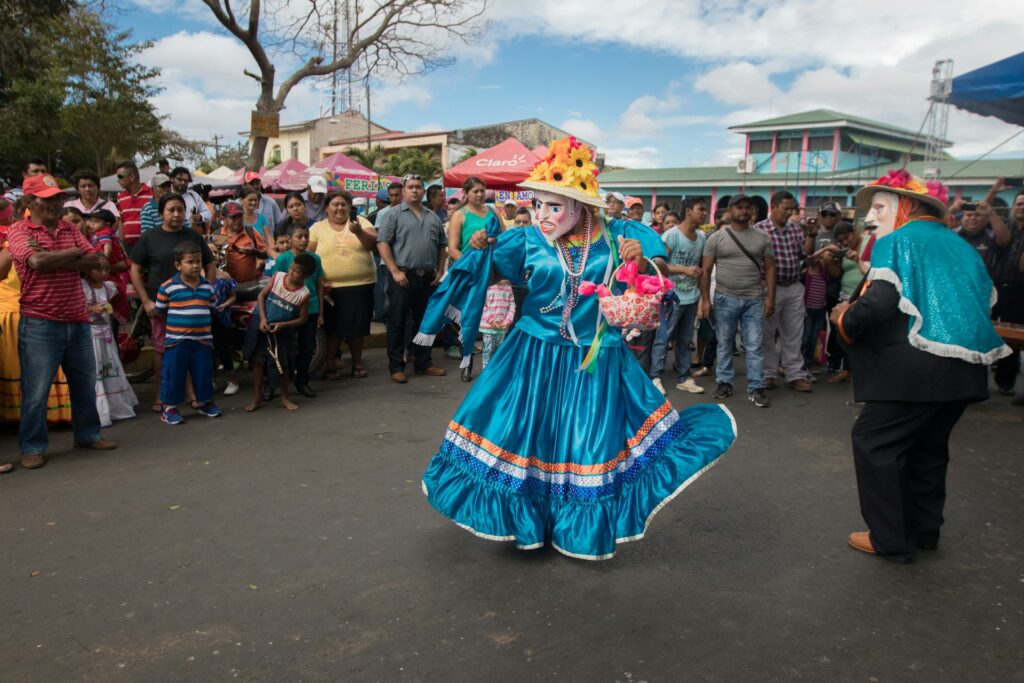Nicaragua, a nation nestled in Central America, boasts a rich cultural heritage woven from a vibrant tapestry of indigenous, European, and African influences. From the pulsating rhythms of Palo de Mayo to the delectable flavours of Gallo Pinto, Nicaraguan culture is a captivating blend of tradition, religion, and artistic expression.
This article delves into the heart of Nicaragua, exploring the customs, beliefs, and festivities that define its unique identity. Buckle up as we embark on a journey to discover the essence of Nicaraguan culture and traditions.
A Fusion of Heritages: Indigenous Roots and Colonial Legacy
Nicaragua’s cultural foundation lies in the amalgamation of indigenous groups like the Nahua and Miskito with Spanish conquistadors. The Nahua influence is evident in the prevalence of corn, a staple food, and the use of Nahuatl words in place names.
The Spanish colonization, spanning over three centuries, left an indelible mark. Catholicism became the dominant religion, shaping festivals and social structures. Spanish also became the official language, although indigenous languages like Miskito and Sumo are still spoken by some communities.
Religion: The Cornerstone of Nicaraguan Life
Religion occupies a central space in Nicaraguan life. Over 70% of the population identifies as Roman Catholic, with a growing presence of Evangelical Protestantism. Religious holidays like Christmas, Easter, and Saint Days are celebrated with gusto, featuring processions, lively music, and traditional foods.
Each city and town has a patron saint, the “Santo Patrono,” celebrated with a dedicated festival. These celebrations are a beautiful fusion of faith and cultural expression, with vibrant parades, dance performances, and fireworks displays.
The veneration of the Virgin Mary holds immense significance. Songs and prayers dedicated to the Virgin Mary’s Immaculate Conception, a tradition dating back to the mid-19th century, resonate throughout December, creating a unique atmosphere of devotion and celebration.
A Celebration of Life: Festivals and Traditional Dances
Nicaraguans are people who find joy in life’s simple pleasures. This zest for life manifests in their numerous festivals, each a vibrant display of music, dance, and community spirit.
Palo de Mayo, a pre-colonial celebration held in May, is a national treasure. People gather around a brightly colored “Palo de Mayo” (May Pole) adorned with ribbons, singing, dancing, and enjoying traditional foods. The lively music and energetic dances, like Palo de Mayo’s own distinctive style, captivate visitors and locals alike.
Another captivating traditional dance is the sensual Zouk (sometimes spelled “Souk”). This dance, with its roots in African traditions, is a passionate display of courtship and sensuality. The Garifuna community, descendants of West Africans who arrived in the Caribbean centuries ago, contribute their unique cultural expression through energetic drumming and lively dances like the Punta.
Also, Check Complete Guide to Nicaragua Cuisine
A Culinary Journey: Flavors of Nicaragua
Nicaraguan cuisine is a delightful blend of indigenous, Spanish, and African influences. Corn, beans, and rice form the base of most dishes, reflecting the region’s agricultural heritage.
Gallo Pinto, the national dish, is a simple yet flavorful combination of rice and black beans, often served with fried plantains, cheese, and fried eggs. For a taste of the coast, try fresh seafood dishes like “Pescado a la Tipica” (fish cooked with tomatoes, onions, and peppers) or mouthwatering lobster.
Nicaraguans also have a sweet tooth. Tres Leches cake, a light and fluffy cake soaked in three kinds of milk, is a national favourite. For a refreshing treat, indulge in “Raspados,” shaved ice flavoured with syrups and fruits.
Beyond the Tourist Trail: Exploring Indigenous and Afro-Caribbean Cultures
While Spanish and Catholic influences dominate the western part of Nicaragua, the eastern regions boast a rich indigenous and Afro-Caribbean heritage.
The Miskito people, inhabiting the northeastern Caribbean coast, have a distinct culture with their own language and traditions. They are skilled artisans, renowned for their intricate woodcarvings and woven baskets. The Garifuna community, residing on the southern Caribbean coast, is known for their lively music, vibrant drumming, and delicious cuisine.
Also, Check Historical Sites in Nicaragua
Beyond the Surface: Warm Hospitality and Family Values
A core aspect of Nicaraguan culture is the warmth and generosity of its people. Nicaraguans take pride in their hospitality and go out of their way to make visitors feel welcome. Family holds immense importance, with strong bonds connecting generations. Respect for elders and a sense of community are ingrained values.
A Look Ahead: The Future of Nicaraguan Culture
Nicaraguan culture is constantly evolving, adapting to modern influences while preserving its rich traditions. The growing tourism industry is showcasing Nicaraguan art, music, and cuisine to a wider audience. However, globalization also presents challenges, such as the potential dilution of traditional practices. The key lies in striking a balance, and embracing the positive aspects of globalization while safeguarding the unique cultural identity that makes Nicaragua so special.
If you plan to visit Nicaragua Villas, check out our private villa. Enjoy a comfortable and peaceful stay with options like villas with private pools in Nicaragua, vacation rentals in Nicaragua, and Nicaragua beach houses in this stunning destination!

